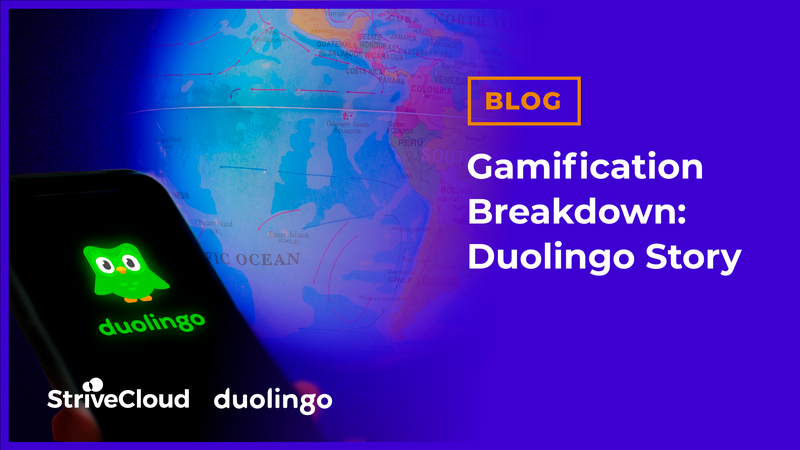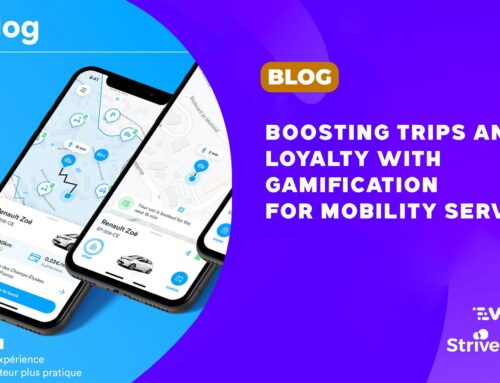How Duolingo uses gamification to improve user retention (+ 5 winning tactics)
If you have ever tried to learn a new language on your phone, you probably know Duolingo! With over 42 million monthly active users, Duolingo is the world leader in educational apps. In other words, they’ve built an app that makes learning fun! The user experience on Duolingo is full of gamification elements that make learning a new language motivating for its users. From daily streaks to points, badges, and leaderboards, Duolingo gamification makes it a perfect case study to improve user retention!
Duolingo’s product manager Zan Gilani himself says the app’s key to success is how it leverages gamification to keep people motivated and engaged. Its badging system has come to define the app. However, Duolingo goes way beyond just badges. They created a fun learning environment that keeps users engaged and conclusively boosts its user retention metrics.

In this article, we’ll tear down exactly how they do it:
- 3 challenges Duolingo overcame with gamification
- How gamification helped Duolingo become the #1 language learning app
- 5 gamification tactics that helped Duolingo improve user retention
- Recap
3 challenges Duolingo overcame with gamification
When Duolingo launched in 2011, it had a simple mission: make learning a language simple, fun, and free. Duolingo developed an interactive learning platform inspired by proven educational methods, such as the theme-based teaching approach. This means that courses are grouped in themes, such as ‘greetings’. According to research studies, this method gives a 45% boost to student results.
However, a mobile app differs a lot from the classroom. Given this, Duolingo faced 3 existential challenges. Today, they have overcome them all with gamification, and become the perfect example of gamification in learning!
#1 Low user retention rate affecting all mobile education apps
First we should establish what a low retention rate means. What is a good retention rate for scale? Generally speaking, you should retain around 20% of your app users after the first day. However, learning apps are far from reaching this. They have one of the lowest user retention rates (1.76%) out of all kinds of mobile apps. Duolingo was no different when it started. In 2012, Duolingo’s next-day user retention was just 12%. This statistic revealed some clear issues with the onboarding process. Especially, the intimidating amount of knowledge that users needed to learn to get ahead.

Obstacles this big are a problem. You can’t learn a language in 1 day, so how can Duolingo help its users learn a new language if they don’t stick around?
Today, it is clear that Duolingo beat the odds. User churn (defined as those who opened the app on a given month, then failed to do so the following month), declined considerably. From around 47% in mid-2020 to around 37% in early 2023. For an app released in 2011, this is a remarkable achievement.
Want to improve your user retention metrics with gamification? Get a free consultation to start!
#2 It’s difficult to keep users motivated over the long run
Improving short-term user retention is one thing, but it can take weeks to see progress in learning a new language. Given this, users need to stay motivated towards reaching their goal! Duolingo gamification played an important role in inspiring long-term motivation in its users.
The learning app managed to keep its users engaged with short-term wins while increasing inherent motivation through genuine progress and skill development. Consequently, customers remained loyal. It’s a proven theory! A study from 2021 found that 80% of language students enjoyed using Duolingo because of its gamification!
#3 Demonstrating real progress in language learning
A key motivational driver in education platforms is the human need for competence. Because it takes a long time to learn a language, any signs of progress might take a while to manifest. That is why loyal customers in the education technology industry don’t come easy. Given this, there needs to be meaningful achievements early on to motivate users.
You see this in most games as well, the first levels are easy and get you hooked on the overall game. As you progress the difficulty increases, but so does your skill level and motivation!
What is gamification and how does it increase user motivation?
How gamification helped Duolingo become the #1 language learning app
Early in Duolingo’s history, the challenges we just mentioned defined the product strategy. Gilani, the company’s most senior product manager, said “We realized we needed to encourage people to form a daily learning habit”.
Gamification is great at making an app ‘sticky’, meaning that users will make a habit of using it. Duolingo gamification case study is proof of that!

Customer retention strategies are hard to navigate for most apps. However, Duolingo has nailed theirs with gamification. Research shows that gamification has a hugely positive effect on Duolingo’s brand equity and user retention. The team developed an effective set of gamification mechanics through extensive A/B testing (for which they have become famous).
Duolingo gamification ranges from the obvious, such as the badge reward system, to the barely noticeable. For example, think of that little red dot over the app icon that indicates a new item, or something unresolved. Just that small feature increased daily active users by 1.6%. While that doesn’t sound like a huge number, they add up when you have millions of users!
By boosting their daily active users bit by bit, Duolingo tackled the problem of user retention. At one point, this was a particular issue.
Initially, Duolingo was losing users during the onboarding process. This is because the app onboarding was focused on sign-ups, to generate email addresses. However, more often than not, new users would ignore their notifications. Remember that 12% next-day user retention rate? Well, the product manager decided to push the sign-up page until after a test lesson. This had a major impact on the number of retained users. It led to a huge 20% jump in next-day user retention!

5 gamification tactics that helped Duolingo improve user retention
Let’s be clear, the gamification mechanics implemented in Duolingo positively affect user motivation. A study revealed that more than 1 in 2 users found Duolingo gamification personally motivating. Let’s take a look at the different gamification mechanics, why they work, and how they made Duolingo the best app for learning:
#1 Using a mascot makes push notifications more personal
Duolingo’s Green Owl is famous and serves more purposes than just marketing. Push notifications can be very intrusive or commanding. Duo’s part in this makes them friendlier, and people are more likely to listen to a friend. Don’t believe it? Well, it’s tested – against other push notifications, the personal greeting from Duo did best and led to a 5% rise in daily active users.

#2 Badge rewards lift referrals & lead generation
Duolingo’s badge reward system saw an impressive 116% jump in referrals. Badges fulfill the basic need for self-worth, an important intrinsic motivator. Users can look at their earned badges and review their progress, or, show off their badges to their friends!
It is key to point out that referrals are an invaluable resource for product managers. They are the most effective form of lead generation! It requires no financial investment and brings in customers more likely to stick around.

#3 Instant feedback gives users control and room for growth
Feedback supports the intrinsic need for growth. Also, immediate corrections lend a sense of control to the user. It’s a great gamification case study for learning. Imagine if the app made you wait to see what you did wrong. That wouldn’t be fun! It would feel like taking an exam unless you’re into that sort of stuff.
What’s more, the pleasing “ping” sound you hear when you answer correctly provides even more positive reinforcement. Studies show that positive reinforcement makes people more motivated to learn!

Keep learners motivated on your app! Discover our gamification platform today.
#4 Leaderboards encourage competition and social interaction
Every time a user completes a course, they earn points that gain them a place on a leaderboard. This feature triggers a sense of competition and the need to prove yourself as a leader. Therefore, it also creates a daily habit, as you wish to collect more points and advance upwards. In addition, the app often shows where your friends are placed, or tells you when they have achieved something. Not only does this provide the opportunity to congratulate friends on progress, but it also motivates you to keep up with your peers!

#5 Streaks give users a reason to come back
The famous streak feature has a huge impact. Of course, it is indispensable in forming the daily habits that Duolingo’s product manager Gilani spoke about. But how do streaks work in user engagement strategies? As an app developer, you use gamification to incentivize behavior in users. A streak incentivizes persistence, and encourages customers to engage with the platform. This turns the app into a sticky experience!
Combined with the ‘weekend amulet’, where users can take a weekend off without losing their streak, you get a winning formula for user retention. Users offered a streak wager see a 14% boost in day 14 user retention!

Finally, a 2% rise here and a 1% jump there might sound inefficient, but Duolingo’s success speaks for itself. From 2017 to 2020, Duolingo’s revenue ballooned over tenfold, jumping from $13 million to $161 million! That’s an enormous increase, and one that the team can agree was based on its strategy of gamification.
Do you want to improve retention and engagement on your app just like Duolingo? You’ll need a bespoke gamification strategy. To start your journey, get in touch with our gamification experts by booking a free consultation!

TLDR;
Duolingo is the world leader in educational apps. In the words of Duolingo product manager Zan Gilani, the app’s key to success is gamification!
Let’s see how they did it:
3 challenges Duolingo overcame with gamification
- Educational apps face chronic user churn. It’s the app category with the lowest user retention rates out of all kinds of mobile apps.
- Language learning requires long-term user motivation. The user experience needs to trigger both extrinsic and intrinsic motivators to be fun and motivating.
- Giving users a chance to see their improvement. Because language learning takes so long, users need to see their growth fast, or they will quit!
Duolingo Gamification Case Study
Gilani, the company’s most senior product manager, said “We needed to encourage people to form a daily learning habit”. For this, the team chose gamification.
Studies show that gamification has a hugely positive effect on Duolingo’s brand equity and user retention. Small features such as a red dot over the course indicate new content boosted daily active users by 1.6%. These numbers all add up!
5 gamification tactics that helped Duolingo improve user retention
✔️ Adding a mascot to push notifications makes it more personal. Duo’s friendly appearance in push notifications led to a 5% rise in daily active users.
✔️ Badges boost user referrals and lead generation. The introduction of badges saw a 116% jump in referrals. Badges fulfill the basic need for self-worth, and you can show them off to the friends you refer! Referrals are one of the best forms of lead generation.
✔️ Instant feedback gives users control and room for growth. Immediate correction gives users a sense of control and supports their improvement with both tips and positive reinforcement.
✔️ Leaderboards encourage competition and social interaction. This feature fulfills the need to win, as well as the need to show off social status. It motivates you as you don’t want to fall behind!
✔️Streaks give users a reason to come back. A streak incentivizes and gamifies persistence, keeping users glued to the app. Users offered a streak wager see a 14% boost in day 14 user retention!
The small boosts in metrics add up – and they sure do in revenue. From 2017 to 2020, Duolingo’s revenue jumped from $13 million to $161 million! That’s an enormous increase, and one that the team can agree was based on its strategy of gamification.



